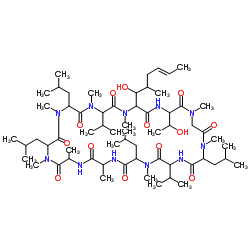Experimental pulmonary eosinophilia in mice by Ascaris suum extract.
M Nogami, M Suko, H Okudaira, T Miyamoto, J Shiga, M Ito, S Kasuya
Index: Am. Rev. Respir. Dis. 141(5 Pt 1) , 1289-95, (1990)
Full Text: HTML
Abstract
The transnasal administration of an extract of the parasite Ascaris suum (Asc) to C57BL/6 mice for 3 wk produced marked eosinophilia in the bronchoalveolar lavage (BAL) fluid. This pulmonary eosinophilia was not accompanied by blood eosinophilia. The oral administration of cyclosporin, 50 mg/kg body weight, every other day significantly suppressed the pulmonary eosinophilia. Athymic C57BL/6-nu/nu mice failed to develop pulmonary eosinophilia. These data indicate that pulmonary eosinophilia caused by this parasite extract is T-cell-dependent. Genetically mast-cell-deficient (WB X C57BL/6)F1-W/WV (W/WV) mice developed marked eosinophilia in the BAL, which shows that mast cells are not necessary in the formation of eosinophilia in BAL in this model. C57BL/6, W/WV, and Balb-C mice that developed eosinophilia in the BAL also showed elevated total IgE levels and IgE titers against Asc in the sera. On the other hand, C57BL/6-nu/nu mice and IgE low-responder SJL mice, which developed little eosinophilia, did not show elevated total IgE levels and IgE titers against Asc in the sera. However, oral administration of cyclosporin, 50 mg/kg, which inhibited eosinophilia in the BAL in C57BL/6 mice, did not significantly inhibit the elevation of total IgE or IgE against Asc in the sera. This indicates that serum IgE production is not required for the formation of eosinophilia.
Related Compounds
| Structure | Name/CAS No. | Molecular Formula | Articles |
|---|---|---|---|
 |
Thr2-Cyclosporine
CAS:59787-61-0 |
C62H111N11O13 |
|
Comparison of the properties of the CsA analogs monoacetyl C...
1992-07-01 [Clin. Exp. Immunol. 89(1) , 136-42, (1992)] |
|
Tachykinin antagonists screening from microbial origin.
1996-01-01 [J. Antibiot. 49(1) , 110-2, (1996)] |
|
Monitoring cyclosporine by HPLC with cyclosporin C as intern...
1993-01-01 [Clin. Chem. 39(1) , 168, (1993)] |
|
Use of 125I-labeled-histamine-cyclosporin C for monitoring s...
1986-03-01 [Clin. Chem. 32(3) , 492-5, (1986)] |
|
Cyclosporin C(2) and C(0) concentration monitoring in stable...
2003-07-01 [J. Heart Lung Transplant. 22(7) , 715-22, (2003)] |